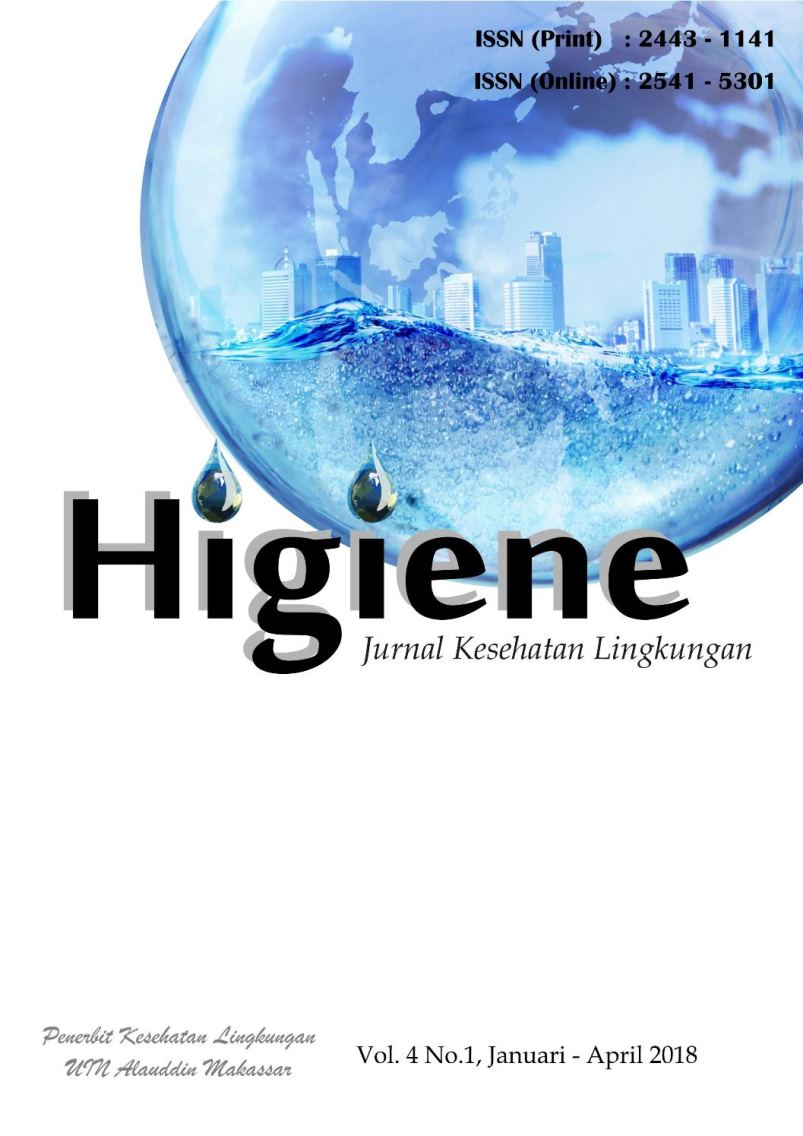Faktor Risiko Lingkungan Yang Berhubungan Dengan Kejadian Pneumonia Pada Balita (Studi di Wilayah Kerja Kerja Dinas Kesehatan Kota Bengkulu)
Abstrak
Pneumonia is a major cause of morbidity and mortality of infectious diseases in the world. In 2010 the incidence of pneumonia in Bengkulu was 5 per 1000 children under 5 years old and in 2011 the incidence increased to 6 per 1000 children under 5 years old. The objective of the study was to analyze the correlation of environmental risk factors related to the incidence of pneumonia in children.
The design was a case-control study and indepth interview done in Sukamerindu health center, Jembatan Kecil health center, Beringin Raya health center, and Lingkar Barat health center. The subjects were pneumonia patients that came for treatment in January 2011 – April 2012 and the respondent house had not experienced an improvement over the last 1 year. Multivariate analysis using multiple logistic regression (confidence interval (CI) of 95% and a = 0,05) was done.
The number cases was 67, control was 67, total sample was 134 .The risk factor for pneumonia was ventilation (p: 0.000; OR: 5.99, 95% CI: 5.52 to 14.23), overcrowding (p: 0.018; OR: 2.94, 95% CI: 1.207 to 7.191), and smokers in the household (p: 0.021; OR: 2.76, 95% CI: 1.162 to 6.579). The variables that proved to be risk factors for the incidence of pneumonia in children are: ventilation, overcrowding, smokers in the household.
Keywords : Pneumonia, Children Under 5 Years Old, Environmental Risk Factors.
Referensi
Arta L, Suhartono, Hanani Y. (2009). Analisis Kondisi Rumah Sebagai Faktor Risiko Kejadian Pneumonia Pada Balita Di Wilayah Puskesmas Sentosa Baru Kota Medan Tahun 2008. J Kesehatan Lingkung Indones. 8(1):26-34.
Depkes RI. (1996). Pedoman Program Penyehatan Lingkungan Pemukiman. Jakarta: Ditjen PPM dan PLP.
Depkes RI. Profil Kesehatan Indonesia (2010). Jakarta: Kementerian Kesehatan Repoblik Indonesia; 2011.
Hidayat S, Yunus F, Susanto AD. (2012). Pengaruh Polusi Udara Dalam Ruangan Terhadap Paru. CDK. 39(1):8-14.
Kemenkes RI. (2011). Pola 10 Besar Penyakit Terbanyak Pada Pasien Rawat Inap Di Rumah Sakit Di Indonesia Tahun 2010. Jakarta: Ditjen Bina Upaya Kesehatan.
Keputusan Menteri Kesehatan Republik Indonesia. (1999). Persyaratan Kesehatan Dan Perumahan Dan Lingkungan Pemukiman. Jakarta: Departemen Kesehatan Republik Indonesia.
Koch A, Molbak K, Homoe P, Sorensen P , Hjuler T, Olesen EM. (2003). Risk Factors for Acute Respiratory Tract Infections in Young Greenlandic Children. American Journal of Epidemiology. 158 (4):374–84.
Saleh, M., Gafur, A., & Aeni, S. (2017). Hubungan Sumber Polutan dalam Rumah Dengan Kejadian Infeksi Saluran Pernafasan Akut pada Balita di Kecamatan Mariso Kota Makassar. HIGIENE: Jurnal Kesehatan Lingkungan, 3(3), 169-176.
Murray JF. (2010). The Year of The Lung. Int J Tuberc Lung Dis 2010;14:1-4.
Nurjazuli, Widyaningtyas R. (2006). Faktor risiko Dominan Kejadian Pneumonia Pada Balita (Dominan risk factors on the occurrence of pneumonia on chlidren under five years). Jurnal Respirologi Indonesia. 29(2):70-88.
Rudan I, Tomaskovic L, Boschi-Pinto C, Campbell H. (2004). Global Estimate Of The Incidence Of Clinical Pneumonia Among Children Under Five Years Of Age. Bull World Health Organ. 82:895-903.
Wantania JM, Naning R, Audrey W. (2010). Infeksi Respiratori Akut. In: Rahajoe NN, Supriyatno B, Setyanto DB, editors. Respirologi Anak. Kedua ed. Jakarta: Badan Penerbit IDAI p. 268-76.
Wahyuningsih, S., Raodhah, S., & Basri, S. (2017). Infeksi Saluran Pernafasan Akut (ISPA) pada Balita di Wilayah Pesisir Desa Kore Kecamatan Sanggar Kabupaten Bima. HIGIENE: Jurnal Kesehatan Lingkungan, 3(2), 97-105
WHO. (2008).Infection prevention and control of epidemic-and pandemic-prone acute respiratory diseases in health care. WHO Interim Guidelines,. Geneva: World Health Organization.
World Health Organization. (2011). Pneumonia Progress Report John Hopkins Bloombang School Of Public Health International Vaccine Acces Center (IVAC).
Yushananta P. (2008). Analisis Pneumonia Pada Balita Di Kota Bandar Lampung Tahun 2007. Ruwa Jurai. 2(2):48-56.
##submission.copyrightStatement##
##submission.license.cc.by4.footer##Informasi Hak Cipta
KEBIJAKAN HIGIENE : JURNAL KESEHATAN LINGKUNGAN (AKSES TERBUKA)
Syarat yang harus dipenuhi oleh Penulis sebagai berikut:
- Penulis menyimpan hak cipta dan memberikan jurnal hak penerbitan pertama naskah secara simultan dengan lisensi di bawah Creative Commons Attribution License yang mengizinkan orang lain untuk berbagi pekerjaan dengan sebuah pernyataan kepenulisan pekerjaan dan penerbitan awal di jurnal ini.
- Penulis bisa memasukkan ke dalam penyusunan kontraktual tambahan terpisah untuk distribusi non ekslusif versi kaya terbitan jurnal (contoh: mempostingnya ke repositori institusional atau menerbitkannya dalam sebuah buku), dengan pengakuan penerbitan awalnya di jurnal ini.
- Penulis diizinkan dan didorong untuk mem-posting karya mereka online (contoh: di repositori institusional atau di website mereka) sebelum dan selama proses penyerahan, karena dapat mengarahkan ke pertukaran produktif, seperti halnya sitiran yang lebih awal dan lebih hebat dari karya yang diterbitkan. (Lihat Efek Akses Terbuka).

